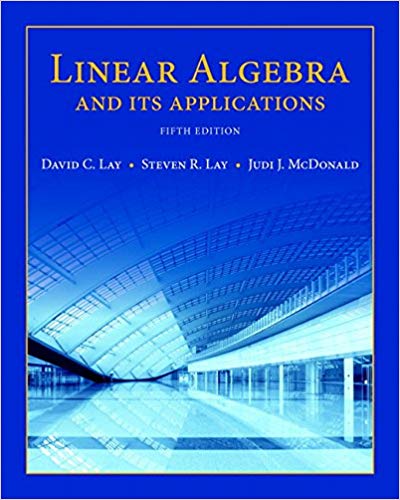
Linear Algebra and Its Applications, 5th Edition
Authors: David C. Lay, Steven R. Lay, Judi J. McDonald
ISBN-13: 978-0321982384
We have solutions for your book!
See our solution for Question 37E from Chapter 1.9 from Lay's Linear Algebra and Its Applications, 5th Edition.
Problem 37E
Chapter:
Problem:
[M] In Exercises, let T be the linear transformation whose standard matrix is given. In Exercises, decide if T is a one-to-one mapping. In Exercises, decide if T maps ℝ5 onto ℝ5. Justify your answers.
Step-by-Step Solution
Given Information
We are given with a matrix: \[A = \left[ {\begin{array}{*{20}{c}} { - 5}&{10}&{ - 5}&4\\ 8&3&{ - 4}&7\\ 4&{ - 9}&5&{ - 3}\\ { - 3}&{ - 2}&5&4 \end{array}} \right]\] We have to find if T is a one-to-one mapping for the given matrix:
Step-1:
If $R^5$ is a linear transformation, then $R^5$ is one-to-one if and only if the equation $T:{R^n} \to {R^m}$ has only trivial solution.
Step-2:
Row-reduce the augmented matrix \[\begin{array}{l} A = \left[ {\begin{array}{*{20}{c}} { - 5}&{10}&{ - 5}&4\\ 8&3&{ - 4}&7\\ 4&{ - 9}&5&{ - 3}\\ { - 3}&{ - 2}&5&4 \end{array}} \right]\\ = \left[ {\begin{array}{*{20}{c}} 1&{ - 2}&1&{\dfrac{{ - 4}}{5}}\\ 8&3&{ - 4}&7\\ 4&{ - 9}&5&{ - 3}\\ { - 3}&{ - 2}&5&4 \end{array}} \right]::\left\{ {{R_1} \to \dfrac{{ - 1}}{5}{R_1}} \right\}\\ = \left[ {\begin{array}{*{20}{c}} 1&{ - 2}&1&{\dfrac{{ - 4}}{5}}\\ 0&{19}&{ - 12}&{\dfrac{{67}}{5}}\\ 4&{ - 9}&5&{ - 3}\\ { - 3}&{ - 2}&5&4 \end{array}} \right]::\left\{ {{R_2} \to {R_2} - 8{R_1}} \right\}\\ = \left[ {\begin{array}{*{20}{c}} 1&{ - 2}&1&{\dfrac{{ - 4}}{5}}\\ 0&{19}&{ - 12}&{\dfrac{{67}}{5}}\\ 0&{ - 1}&1&{\dfrac{1}{5}}\\ { - 3}&{ - 2}&5&4 \end{array}} \right]::\left\{ {{R_1} \to {R_3} - 4{R_1}} \right\}\\ = \left[ {\begin{array}{*{20}{c}} 1&{ - 2}&1&{\dfrac{{ - 4}}{5}}\\ 0&{19}&{ - 12}&{\dfrac{{67}}{5}}\\ 0&{ - 1}&1&{\dfrac{1}{5}}\\ 0&{ - 8}&8&{\dfrac{8}{5}} \end{array}} \right].::\left\{ {{R_4} \to {R_4} + 3{R_1}} \right\}\\ = \left[ {\begin{array}{*{20}{c}} 1&{ - 2}&1&{\dfrac{{ - 4}}{5}}\\ 0&1&{\dfrac{{ - 12}}{{19}}}&{\dfrac{{67}}{{95}}}\\ 0&{ - 1}&1&{\dfrac{1}{5}}\\ 0&{ - 8}&8&{\dfrac{8}{5}} \end{array}} \right]::\left\{ {{R_2} \to \dfrac{1}{{19}}{R_2}} \right\}\\ = \left[ {\begin{array}{*{20}{c}} 1&0&{\dfrac{{ - 5}}{{19}}}&{\dfrac{{58}}{{95}}}\\ 0&1&{\dfrac{{ - 12}}{{19}}}&{\dfrac{{67}}{{95}}}\\ 0&{ - 1}&1&{\dfrac{1}{5}}\\ 0&{ - 8}&8&{\dfrac{8}{5}} \end{array}} \right]::\left\{ {{R_1} \to {R_1} + 2{R_2}} \right\}\\ = \left[ {\begin{array}{*{20}{c}} 1&0&{\dfrac{{ - 5}}{{19}}}&{\dfrac{{58}}{{95}}}\\ 0&1&{\dfrac{{ - 12}}{{19}}}&{\dfrac{{67}}{{95}}}\\ 0&0&{\dfrac{7}{{19}}}&{\dfrac{{86}}{{95}}}\\ 0&{ - 8}&8&{\dfrac{8}{5}} \end{array}} \right]::\left\{ {{R_1} \to {R_3} + {R_2}} \right\}\\ = \left[ {\begin{array}{*{20}{c}} 1&0&{\dfrac{{ - 5}}{{19}}}&{\dfrac{{58}}{{95}}}\\ 0&1&{\dfrac{{ - 12}}{{19}}}&{\dfrac{{67}}{{95}}}\\ 0&0&{\dfrac{7}{{19}}}&{\dfrac{{86}}{{95}}}\\ 0&0&{\dfrac{{56}}{{19}}}&{\dfrac{{688}}{{95}}} \end{array}} \right]::\left\{ {{R_4} \to {R_4} + 8{R_2}} \right\}\\ = \left[ {\begin{array}{*{20}{c}} 1&0&{\dfrac{{ - 5}}{{19}}}&{\dfrac{{58}}{{95}}}\\ 0&1&{\dfrac{{ - 12}}{{19}}}&{\dfrac{{67}}{{95}}}\\ 0&0&{\dfrac{7}{{19}}}&{\dfrac{{86}}{{95}}}\\ 0&0&0&0 \end{array}} \right]::\left\{ {{R_4} \to {R_4} - 8{R_3}} \right\} \end{array}\] We can see that the system does not have a trivial solution, then
The transformation is not one-to-one
We are given with a matrix: \[A = \left[ {\begin{array}{*{20}{c}} { - 5}&{10}&{ - 5}&4\\ 8&3&{ - 4}&7\\ 4&{ - 9}&5&{ - 3}\\ { - 3}&{ - 2}&5&4 \end{array}} \right]\] We have to find if T is a one-to-one mapping for the given matrix:
Step-1:
If $R^5$ is a linear transformation, then $R^5$ is one-to-one if and only if the equation $T:{R^n} \to {R^m}$ has only trivial solution.
Step-2:
Row-reduce the augmented matrix \[\begin{array}{l} A = \left[ {\begin{array}{*{20}{c}} { - 5}&{10}&{ - 5}&4\\ 8&3&{ - 4}&7\\ 4&{ - 9}&5&{ - 3}\\ { - 3}&{ - 2}&5&4 \end{array}} \right]\\ = \left[ {\begin{array}{*{20}{c}} 1&{ - 2}&1&{\dfrac{{ - 4}}{5}}\\ 8&3&{ - 4}&7\\ 4&{ - 9}&5&{ - 3}\\ { - 3}&{ - 2}&5&4 \end{array}} \right]::\left\{ {{R_1} \to \dfrac{{ - 1}}{5}{R_1}} \right\}\\ = \left[ {\begin{array}{*{20}{c}} 1&{ - 2}&1&{\dfrac{{ - 4}}{5}}\\ 0&{19}&{ - 12}&{\dfrac{{67}}{5}}\\ 4&{ - 9}&5&{ - 3}\\ { - 3}&{ - 2}&5&4 \end{array}} \right]::\left\{ {{R_2} \to {R_2} - 8{R_1}} \right\}\\ = \left[ {\begin{array}{*{20}{c}} 1&{ - 2}&1&{\dfrac{{ - 4}}{5}}\\ 0&{19}&{ - 12}&{\dfrac{{67}}{5}}\\ 0&{ - 1}&1&{\dfrac{1}{5}}\\ { - 3}&{ - 2}&5&4 \end{array}} \right]::\left\{ {{R_1} \to {R_3} - 4{R_1}} \right\}\\ = \left[ {\begin{array}{*{20}{c}} 1&{ - 2}&1&{\dfrac{{ - 4}}{5}}\\ 0&{19}&{ - 12}&{\dfrac{{67}}{5}}\\ 0&{ - 1}&1&{\dfrac{1}{5}}\\ 0&{ - 8}&8&{\dfrac{8}{5}} \end{array}} \right].::\left\{ {{R_4} \to {R_4} + 3{R_1}} \right\}\\ = \left[ {\begin{array}{*{20}{c}} 1&{ - 2}&1&{\dfrac{{ - 4}}{5}}\\ 0&1&{\dfrac{{ - 12}}{{19}}}&{\dfrac{{67}}{{95}}}\\ 0&{ - 1}&1&{\dfrac{1}{5}}\\ 0&{ - 8}&8&{\dfrac{8}{5}} \end{array}} \right]::\left\{ {{R_2} \to \dfrac{1}{{19}}{R_2}} \right\}\\ = \left[ {\begin{array}{*{20}{c}} 1&0&{\dfrac{{ - 5}}{{19}}}&{\dfrac{{58}}{{95}}}\\ 0&1&{\dfrac{{ - 12}}{{19}}}&{\dfrac{{67}}{{95}}}\\ 0&{ - 1}&1&{\dfrac{1}{5}}\\ 0&{ - 8}&8&{\dfrac{8}{5}} \end{array}} \right]::\left\{ {{R_1} \to {R_1} + 2{R_2}} \right\}\\ = \left[ {\begin{array}{*{20}{c}} 1&0&{\dfrac{{ - 5}}{{19}}}&{\dfrac{{58}}{{95}}}\\ 0&1&{\dfrac{{ - 12}}{{19}}}&{\dfrac{{67}}{{95}}}\\ 0&0&{\dfrac{7}{{19}}}&{\dfrac{{86}}{{95}}}\\ 0&{ - 8}&8&{\dfrac{8}{5}} \end{array}} \right]::\left\{ {{R_1} \to {R_3} + {R_2}} \right\}\\ = \left[ {\begin{array}{*{20}{c}} 1&0&{\dfrac{{ - 5}}{{19}}}&{\dfrac{{58}}{{95}}}\\ 0&1&{\dfrac{{ - 12}}{{19}}}&{\dfrac{{67}}{{95}}}\\ 0&0&{\dfrac{7}{{19}}}&{\dfrac{{86}}{{95}}}\\ 0&0&{\dfrac{{56}}{{19}}}&{\dfrac{{688}}{{95}}} \end{array}} \right]::\left\{ {{R_4} \to {R_4} + 8{R_2}} \right\}\\ = \left[ {\begin{array}{*{20}{c}} 1&0&{\dfrac{{ - 5}}{{19}}}&{\dfrac{{58}}{{95}}}\\ 0&1&{\dfrac{{ - 12}}{{19}}}&{\dfrac{{67}}{{95}}}\\ 0&0&{\dfrac{7}{{19}}}&{\dfrac{{86}}{{95}}}\\ 0&0&0&0 \end{array}} \right]::\left\{ {{R_4} \to {R_4} - 8{R_3}} \right\} \end{array}\] We can see that the system does not have a trivial solution, then
The transformation is not one-to-one